There is no "S" in HBBR
12
12
|
|
So I'm going out on a limb here and suggesting that there appear to be no rules about discussing motor boats in this forum? Or more like converting a sailboat to a motor boat?
Summer has arrived here with a vengance along with our third La Nina weather system in 3 years so we are expecting hot and wet down here for the next 4 months. It's just too hot to go sailing in an open boat. We already have the UV index at 12 and it will be 14 before too long. By the time I suit up to protect against UV I'm sweltering in the heat. So I'm thinking of having a summer Kalliope and winter Kalliope. Has anybody got any suggestions on how I could fabricate a "fantail launch" style canopy which is removable. I would intend on mounting a solar module or two on the roof and run an electric outboard (I know 24lbs isn't enough but a 44 lb trolling motor should do the job with 3.5HP mercury backup to cover strong head winds and currents). I've been sketching some ideas. With roll down awnings to keep the rain out. This could be a good means of pottering around the southern bay islands and various rivers and lakes. 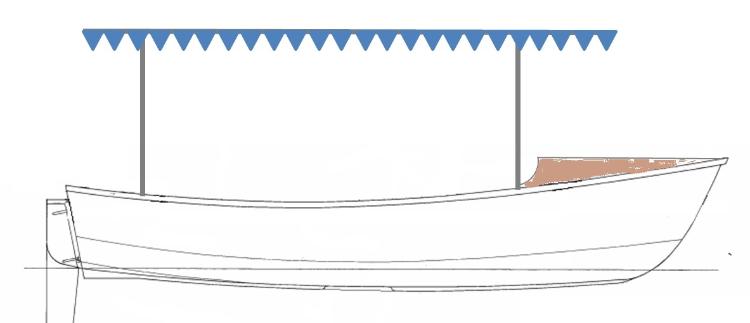 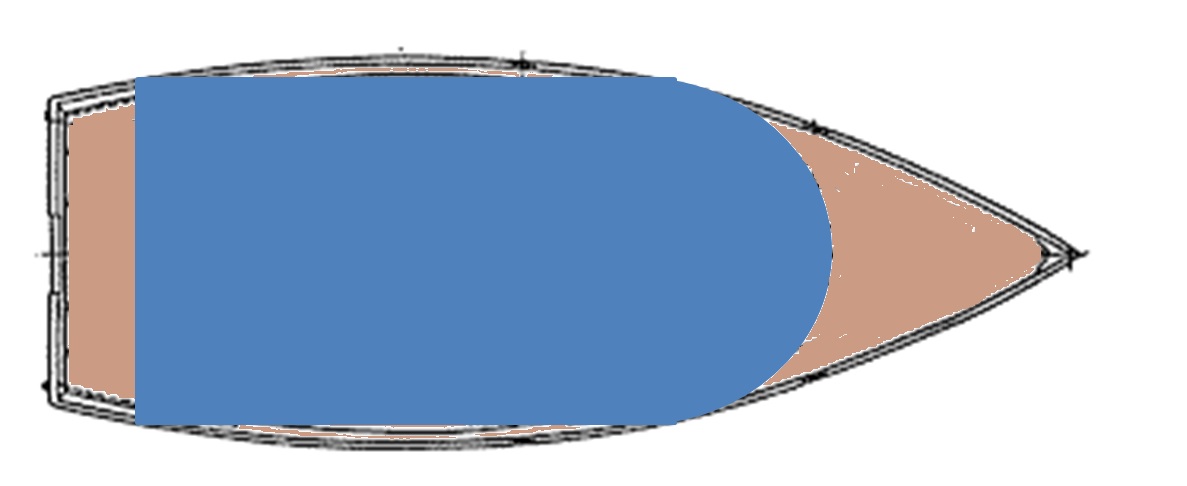 Jason (yes Queensland Australia....) |
|
|
Hi Jason
One of the most appealing features of the HBBR is the lack of rules, though you might get raised eyebrows if you wanted to build a jetski I suppose. In any case Paul Hadley has already converted his Lynx to electric power and no one hauled him before the committee. I am sure he will have views on your plans. They look fine to me. I personally want to build an electric canoe to glide round our local waters in silent grace. Something like this, tho' sadly the prospects for actually doing this anytime soon are slim. 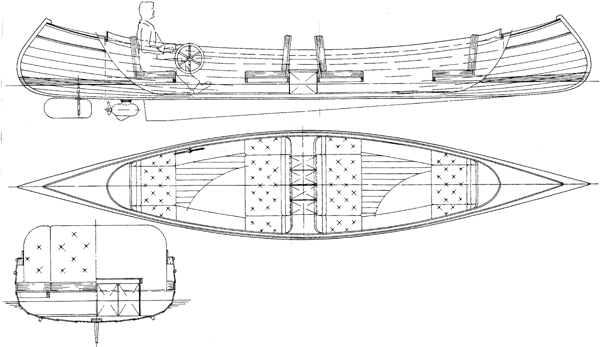
|
|
|
In reply to this post by Jason Mayer
Jason,
Google 'Bimini frame". They are folding sun shades popular with petrol heads. You may find something useful. In the distant past, when dinosaurs roamed the Thames path with the "young" HBBR crew, I bolted a 180 Watt panel to MilliBee's cabin. Stainless hinges at the front, wood supports bolted at rear. The panel could lay flat or the wood supports swung down to hold the panel at an angle facing the sun. An X shaped frame might allow you to drop the panels flat, to tow her home. Paul |
|
|
That's one hell of a canoe Chris, looks like absolute luxury.
Paul how many watts did your motor draw? Mine is 240W which gives 24 lbs of thrust and about 3 knots in calm water. I believe I need 44 lbs of thrust to better the currents and wind, which incidentally appears to be 44A according to the datasheet. So I would need 500W plus losses, so around 600W of panels to break even for infinite cruising. Then just a single battery to cover the gaps. Facebook marketplace has thousands of solar modules for sale (some new from overbuying) being sold at <40c/Watt. Good place to start to experiment. First job is the shade cover though, I can motor with the tiny outboard for hours on 5 litres of fuel. Then I can see what can be done with electrics to quieten the whole show down. I'd like to build something from wood to match the boat and look more stylish than the old aluminium bimini. |
|
|
In reply to this post by Chris Partridge
Provided the JetSki was built from glued lapstrake birch ply with a lug rig option and a sculling notch as well as a 500hp inboard engine it could fit right in round here.
|
|
|
So this is off the cards then?
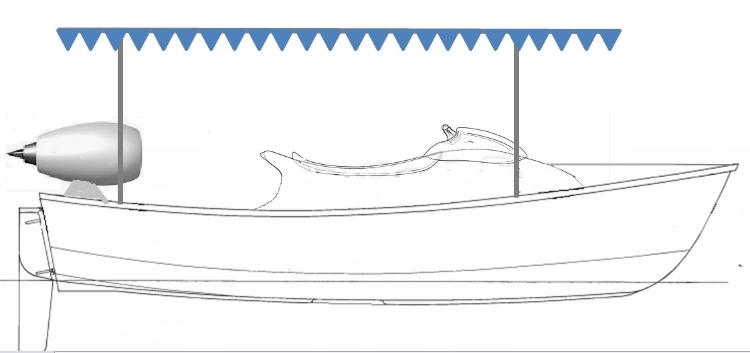 |
|
|
No objection from me and love the pulse jet power unit, very top gear or scrapheap challenge!
It might be a bit to fast for the Thames though but fun to see the river police trying to catch you  Steve |
|
|
In reply to this post by Jason Mayer
That looks right up the HBBR street.
A stitch and tape plywood panel build. Let CW near it and he'll add a lug rig (with lazyjacks), rowlocks, a pedalyuloh and a bed to it in no time. Will certainly be painted grey. The auxiliary power unit will not phase many of us, probably quieter than a Seagull outboard. Those with a history in the aerospace world may even declare they've an old one in the garage somewhere left over from an unfinished project. At least a couple of our 'members' could well offer cogent and learned advice on doubling its power output while halving its fuel consumption. Better still ask for advice about how to power and rig it and you'll have 10 conflicting but very lucidly argued suggestions within the day. Wot larks! |
|
|
How did you know TimmO?
The PRRB (Perfect River Raid Boat) is next in line, ply ready to go, right on the tip of my garage; unfortunately 'tip' is he only way to describe it. You have every important item on your list, though I have just been wondering about a somewhat different rig.... Ahaa! Chris W |
|
|
Ply? You have Ply?
What Ply? Whither Came this Ply and from Whence? 4mm, 6mm, 2440 x 1220 or some Imperial 1/4" 8' x 4' Birch or an exotic spicy species from somewhere East of Java. Krakatoa? Stubbed not Broken. Maybe I'll give Totton Timber a ring. Have people noticed no-one is publishing prices in these days of hyper-inflation? |
|
|
In reply to this post by Chris Waite
Look forward to the drawings, and then a finished result.
|
|
|
In reply to this post by Port-Na-Storm
The ply, Grum?
It's a standard size 4mm (??3.5mm) thick and I suppose four by eight foot within a tad, from Jewsons. Chinese origin I think, though that says nothing regarding which forest it was ripped from; the label waffles a bit about being water-resistant, but not to be exposed to rain or something. I bought it a year or two ago, in the great metrollops of Havant. It will get my usual treatment, epoxy with Tesco's polycotton sheet sheathing and finished in grey two-part polyurethane as surmised by TimmO.... and that will have to do. Sixteen inches wide each side of the bottom and the same sixteen inches for the sides, so each sheet will provide three half pieces. Sixteen feet round the sides and forty-five inches maximum beam. Having my Premise formula firmly in mind, I do not bother with a plan, but go straight to a model -    Curvy Mabel will not be too different from Octavia, but slightly beamier with a flat bottom. the diagram shows Octavia's mid-section inside that of Curvy Mabel - 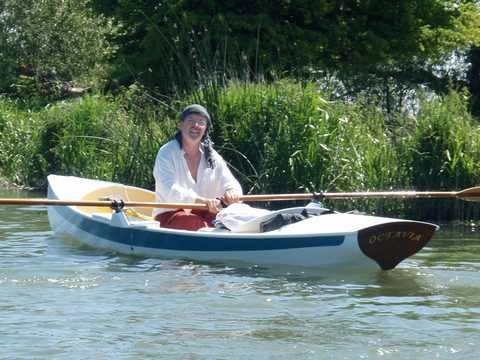  Oars, sail, Peduyloh all included As well as a bed - lovely Chris W |
|
|
Back to the task at hand, before I get too excited about electric motors, I would like to build a proper foredeck. The tiny one I built was just a slightly too long piece of wood wedged and epoxied between the gunnels and a piece of ply over it. Not structural in any sense.
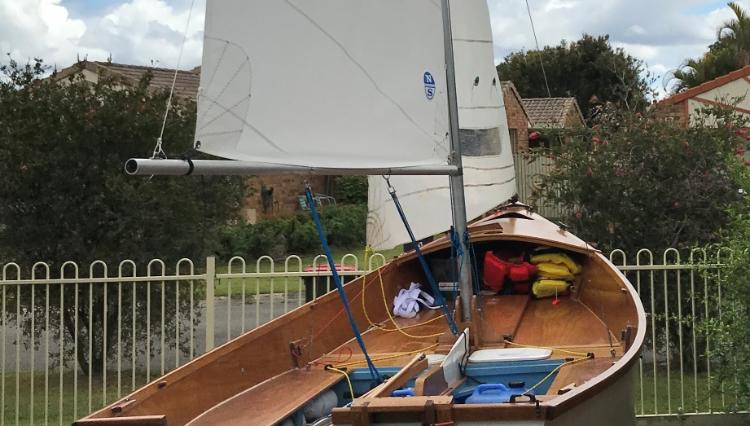 Any suggestions for a proper deck with beams and king plank? I was thinking of leaving the mast tabernacle where it is and just bringing the foredeck back to the mast, maybe curving it around slightly behind the mast with some lodging knees. Then I would have some structure to put the chain plates on the outside of the hull instead of the side seat where Dudley put them because the sheer it too springy (if I decide to keep her as a sailor). Suggestions, ideas, photos much appreciated. You will note that the bow of the Argie sweeps up hence my question. Do I keep the deck horizontal by increasing the crown as I go back or do I keep the same crown radius and let the deck follow the lines? I heard the traditional deck crown was 1 1/2" per 5 feet?? 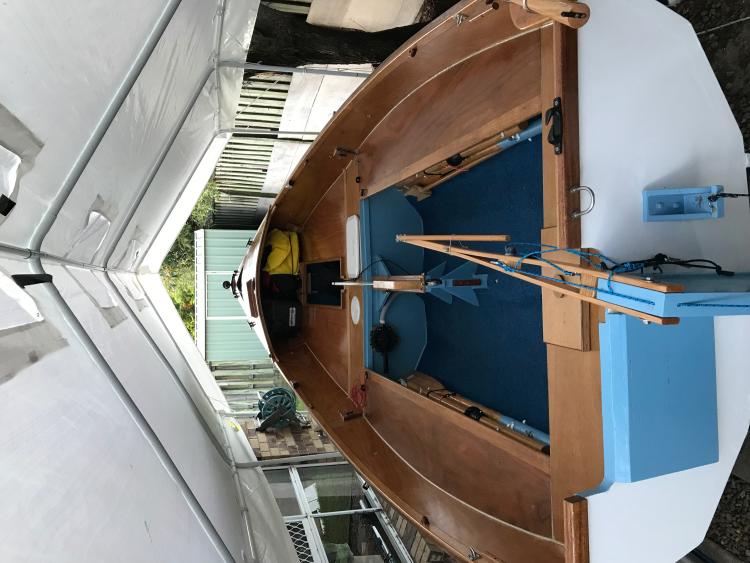 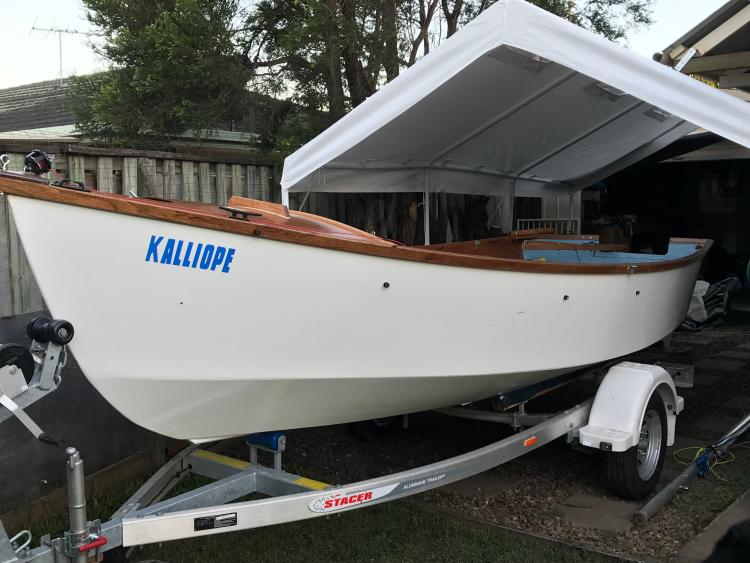 |
|
|
Jason,
Why do you want a longer foredeck? It looks like you have easy access along the boat. A longer foredeck could complicate anchoring. Climbing over a foredeck is hard in rough weather etc. |
|
|
I was thinking about better weather protection. Bring the deck back to the mast and the bimini or boom tarp (or whatever I end up with) going forward to the mast with minimal gap for the rain to get into the hull.
I found this in the 1967 Heron building guide.....sort of what I was thinking would be the way to build a deck properly. 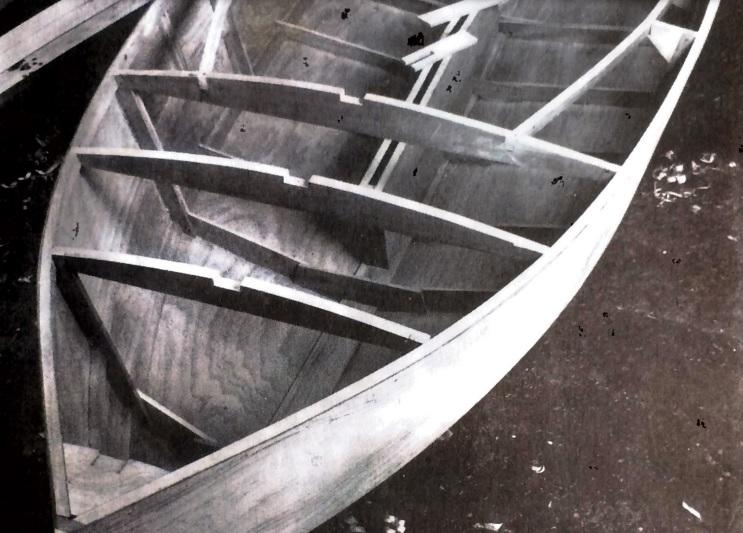
|
|
|
I don't want to go as crazy as my Flying Fifteen though. 20 feet long and hardly an ounce of room to move due to the huge fore and aft and side decks. Great for actual sailing but useless for cruising and camping.
https://www.youtube.com/watch?v=yixptgk9j6o Jason |
|
|
In reply to this post by Jason Mayer
That Heron photo has the King post missing.
In a stiff epoxy boat you just need a King plank, to laminate thin ply in a slight curve. The plank lies on a King beam - the epoxy monocoque can be strong enough to support the beam without a post. Of course you have the tabernacle to consider, which needs support. For the Lynx14 there is a strong King beam to support the foredeck, leaving sleeping space underneath. The cabin front makes the beam very strong. The Lynx mast is deck stepped above an 18mm bulkhead - sort of horse shoe sized like a classic arch. It's rock solid. Que the jokes about classic rock!😀 Paul |
|
|
In reply to this post by Jason Mayer
Have a look at the decking for the "Lillie" in the other section on builds in progress. I've a deck at both ends !! But the construction is there.
Richard |
|
|
In reply to this post by Jason Mayer
Under most circumstances a foredeck is a real boon
The idea that you should avoid one on the grounds that it gets in the way going forward fails to recognize the multitude of benefits. If you are in rough weather then going forward in a dinghy decreases stabilty anyway and increases the likelyhood of taking water over the bow, which will end up in the bilges, or even swamping the boat, rather than running away overboard. Anchoring and any other foredeck activity should be minimized in a dinghy, for cruising purposes this means having an outhaul to the stem head for anchor and mooring lines and another for the headsail tack. To make best use of it, the deck should be well cambered, which not only sheds water, but improves the space available underneath. As is frequently the case, I suggest the deck should come aft as far as the mast, which can be deck or keel stepped as you choose. Then it should run back to the chainplates, either in a curve or as a 'V' shape depending on your preference and woodworking skills. A kingplank is the best option as it binds the whole structure togther and gives you somewhere solid to mount all the midline fittings from the stemhead to the mast step (or 'partners' - where the mast fits through the deck). Remember to locate the main cleat somewhere you can reach it while standing in the cockpit as you're never going to venture out on the foredeck anyway, are you? I suggest that even a horizontal kingplank would not over emphasize the camber - 
Depending on your intentions, the deck would be fine in 6mm ply and possibly even 4mm, though the latter is perhaps a little flimsy for a boat the size of the Argie 15, where depending on the number of beams underneath (one or two should do) it might turn out a tad undulated. Polly Wee has a 4mm thick foredeck with no deck beams, but the forward main bulkhead is (just ahead of the mast) well toward the stem. The final decision is regarding the 'spurnwater'. Some racing boats do not have any coaming around the aft end of the foredeck, but for cruising at least some form of upstand is desirable and you could even go as far as a cudulette - 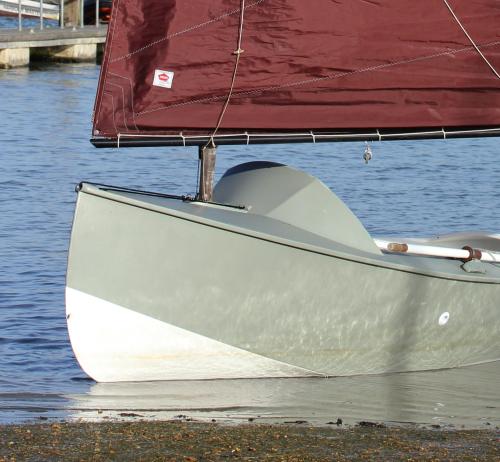 I've never regretted mine Chris |
|
|
Thanks Chaps, that gives me a few ideas.
|
«
Return to General Discussion
|
1 view|%1 views
| Free forum by Nabble | Edit this page |

